Are you an artist or creative looking for a high-performance solution to showcase your work on WordPress? Whether you’re a designer, artist, photographer, or creative freelancer, creating an online portfolio of work is likely to be a necessity for you. However, with so many available options for how to do this, it can be difficult to know where to start.
If you’re using WordPress, there are various third-party portfolio plugins available. WordPress portfolio plugins add functionality to showcase visual work through customizable galleries and layouts. These plugins enable users to display projects without changing themes.
In many instances, they may not all offer the performance you need and often sacrifice Core Web Vitals and page speed scores for visual features, leading to poor user experience. Understanding what features to look for is key to creating a visually appealing, high-performing portfolio. In this article, we’ll explore our top portfolio plugins for creatives on WordPress, looking at optimization features, responsive image handling, and WebP support across eight carefully selected plugins.
WordPress Posts vs Portfolio Items
When building your creative showcase, understanding the distinction between standard posts and portfolio items makes a crucial difference. A WordPress post is a time-based content type appearing in Rich Site Summary or RSS feeds. A portfolio item is a custom post type for visual work.
Portfolio items exclude themselves from RSS feeds, reducing server load on your site while keeping your creative work separate from blog content. This separation means a cleaner organization and better performance, especially when you’re dealing with high-resolution imagery.
Posts are organized with categories and tags. Portfolio items use custom taxonomies that you can tailor specifically to your creative needs – think project types, client names, or skill categories. This specialized structure helps potential clients find exactly what they’re looking for in your work.
Choose posts when you’re documenting your creative process, sharing industry insights, or building thought leadership content. Reserve portfolio items for showcasing finished projects, case studies, and visual galleries that demonstrate your professional capabilities.
Essential Portfolio Plugin Features
Before diving into specific plugins, let’s establish the non-negotiable features your portfolio needs:
- Lazy loading reduces initial page load time.
- Responsive layouts adapt to all devices.
- Multiple gallery layouts include grid, masonry, and slider options.
- Filtering allows category sorting, making it simple for visitors to browse specific project types or styles in your portfolio.
- Lightbox displays full-size images without page reloads, keeping viewers engaged with your work rather than waiting for new pages to load.
Portfolio sites face unique performance challenges since they often need to have a combination of high-resolution images, complex layouts, and interactive elements. These ensure that the portfolio is visually aesthetic, which is a key factor for any creative website.

Because of this, they are often the heaviest type of WordPress site in terms of media, and yet they also need to be the fastest to impress potential clients. This creates a ‘perfect storm’ of performance challenges that only specialized plugins can solve. The right tools strike that balance, lightening the load without compromising on quality. Performance-optimized plugins maintain fast load times while handling high-resolution images, ensuring your portfolio impresses without frustrating visitors.
Portfolio sites present a unique performance paradox. They demand high-resolution imagery, sophisticated layouts, and interactive elements to showcase creative work effectively. Yet this makes them among the heaviest WordPress sites in terms of media assets – precisely when they need to be at their fastest to capture potential clients. It’s a perfect storm that standard optimization approaches simply can’t weather alone.
Elvis Omondi, Lead Support at FooPlugins
8 Best Portfolio Plugins Compared
The following plugins represent the most widely-used portfolio solutions, from performance-focused options like FooGallery to template-rich alternatives like Essential Grid.
Portfolio Plugin Comparison Table
| Plugin | Best For | Lazy Loading | WebP Support | Starting Price | Performance Impact |
| FooGallery | 100+ image galleries | Yes | Yes | $33.99/year | Minimal |
| Visual Portfolio | Dynamic layouts | Yes | Partial | Free | Minimal |
| Envira Gallery | Drag-and-drop creation | Yes | Yes | $39.50/year | Low |
| Modula | Masonry grids | Yes | Yes | $39/year | Low |
| WP Portfolio | Website portfolios | Yes | No | $49/year | Moderate |
| Imagely | Ecommerce integration | Yes | Yes | $69.50/year | Moderate |
| GridKit Portfolio | Interactive animations | Yes | No | Free | Low |
| Essential Grid 3 | 50+ templates | Yes | Yes | $34/year | Moderate |
Below you will find a detailed description of these top WordPress Portfolio plugins, with a focus on real performance metrics and options that will help your website load quickly. Plus, we look at general functionality, customization features, and integration with page builders to give you a solid understanding of your options.
1. FooGallery
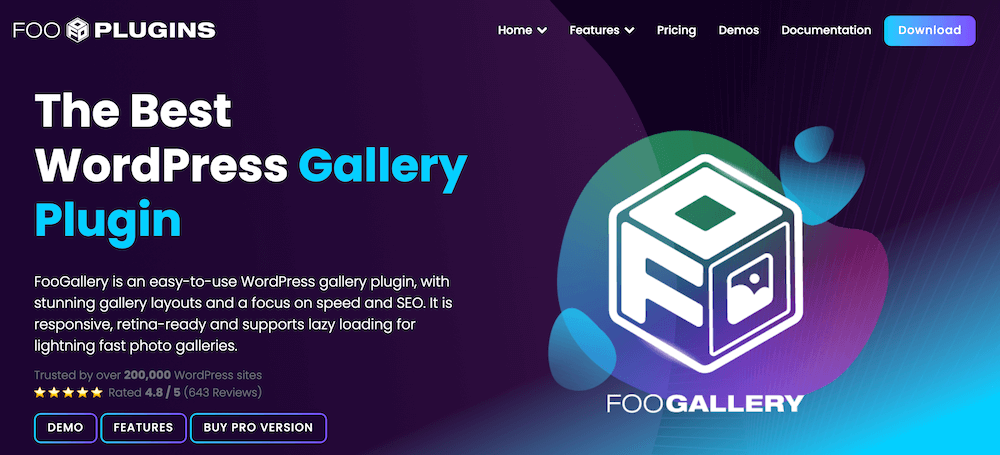
FooGallery is a WordPress portfolio plugin that serves 100,000+ active sites with advanced performance optimization.
Best for: photographers with 100+ images needing sub-3-second load times.
FooGallery can be seen as the ultimate WordPress portfolio plugin, especially when considering its rich feature set and high performance. By using FooGallery, you can make your portfolio stand out from the competition, with beautiful gallery templates and organization features. The plugin supports JPEG, PNG, GIF, and WebP formats. WooCommerce integration enables direct image sales.
FooGallery’s portfolio-specific capabilities include he following must-have features:
- Speed optimization features, such as lazy loading implementation and optimized image loading sequences. This ensures a faster page-load time, which is beneficial for both user experience and search engine optimization.
- 11 different portfolio-specific layouts, such as grid portfolios, slider portfolios, and the more whimsical Polaroid PRO portfolio. All FooGallery layouts are responsive to accommodate different devices and screen sizes, and all of them can be customized to suit your brand.
- FooGallery PRO Expert offers advanced customization with a multi-level filtering system, the ability to add custom captions to thumbnail images and the lightbox, and video support for mixed-media portfolios. You can also enable deep linking for your galleries.

- The plugin’s watermarking and right-click protection features safeguard your creative work from unauthorized use, particularly valuable for professional photographers and artists selling their work online. These security features integrate seamlessly with the PRO Commerce plan’s WooCommerce functionality
- The plugin is supported by popular page builders, and you can customize your portfolio further with custom CSS options.
- The PRO Commerce plan integrates fully with WooCommerce and includes watermarking and right-click image protection, along with white labeling and Gallery Blueprints.
FooGallery is available in three different plans, each with progressively more features, to accommodate different needs and budgets. The PRO Starter plan is available from $33.99 per year, but creators and photographers are likely to prefer the PRO Expert plan, which allows for video support, multi-level filtering, portfolio search, and custom captions to give more control over the presentation of your work. This starts at $69.99 a year.
The Best WordPress Gallery Plugin
FooGallery is an easy-to-use WordPress gallery plugin, with stunning gallery layouts and a focus on speed and SEO.
2. Visual Portfolio
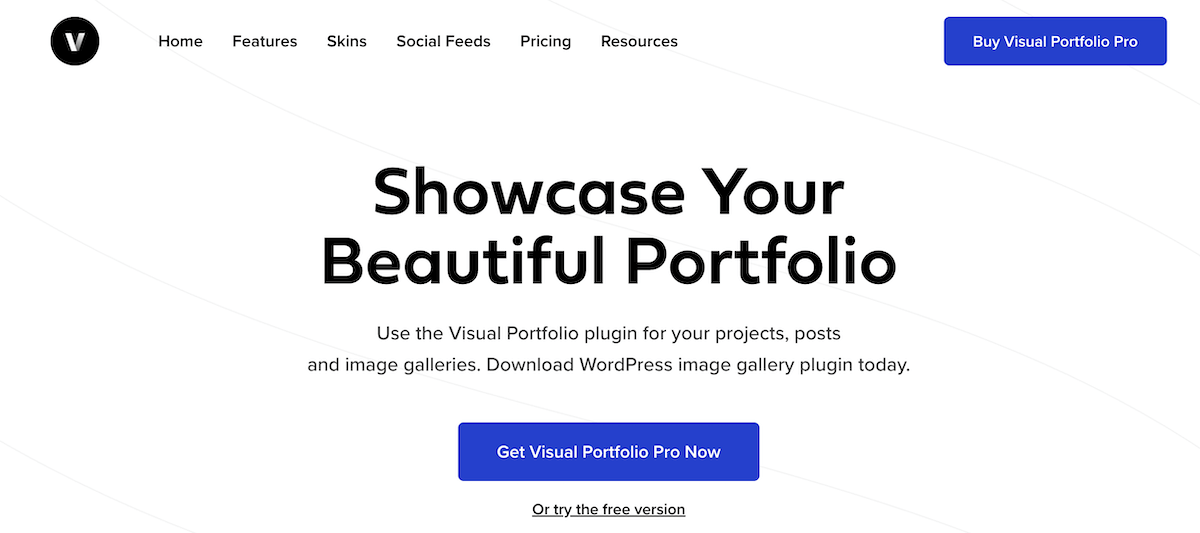
Visual Portfolio is a WordPress portfolio plugin that offers multiple layouts, including masonry, grid, and carousel options.
Best for: agencies creating dynamic portfolios with advanced filtering.
This plugin stands out with its deep Gutenberg integration, making it incredibly intuitive for users already familiar with WordPress’s block editor. The free version includes essential features like lazy loading, custom CSS options, and basic filtering capabilities.
Visual Portfolio handles responsive breakpoints automatically, adjusting your galleries at 768px for tablets and 480px for mobile devices. The plugin’s AJAX-powered filtering creates smooth transitions without page reloads, maintaining visitor engagement throughout their browsing experience.
- Premium features unlock advanced hover effects and additional layout variations.
- Supports video portfolios from YouTube, Vimeo, and self-hosted sources.
- Includes social sharing buttons for Instagram and Pinterest integration.
While Visual Portfolio offers excellent dynamic layouts, FooGallery’s performance optimization and extensive customization options provide more control for users managing large image libraries.Visual Portfolio offers a free version to get started, with premium plans starting at $39/year for use on one site and scaling up to support multiple sites and agency-level usage.
3. Modula

Modula is a WordPress portfolio plugin specializing in customizable masonry grid layouts with drag-and-drop simplicity.
Best for: non-technical users wanting customizable masonry grids.
Modula is a WordPress gallery solution for ‘non-technical users’, which could apply to users who need a portfolio. It has striking customizable masonry grid gallery templates, or you can specify a height for your gallery and the plugin will arrange your images within the space defined. This makes it an easy-to-use option.
Modula’s proprietary CDN loads galleries 2x faster with the Trio plan, significantly improving performance for image-heavy portfolios. The plugin automatically generates multiple image sizes for optimal delivery across different devices and connection speeds. Aside from this, there are several unique features such as password-protected galleries, watermarking, white-labeling, and pagination.
Modula’s pricing will depend on the plan you choose: the basic plan costs $39 per year, but we suggest using at least the Trio plan (at $69 a year) to benefit from the range of image speed optimization features that aren’t available with the basic plan. Unlike FooGallery’s comprehensive WooCommerce integration, Modula focuses primarily on gallery presentation rather than sales functionality.
4. Envira Gallery
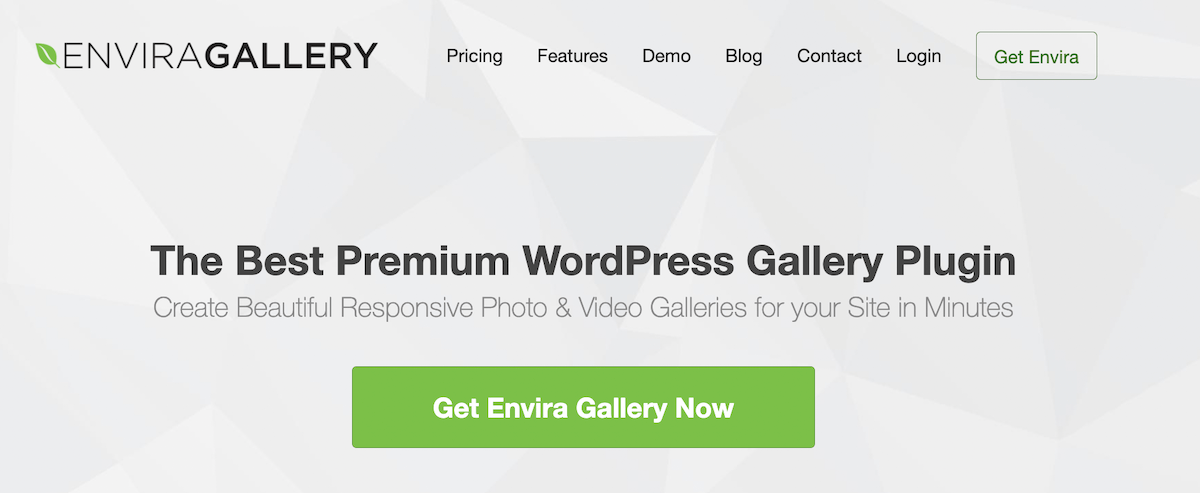
Envira Gallery is a WordPress portfolio plugin featuring intuitive drag-and-drop gallery building for quick setup.
Best for: creative professionals needing drag-and-drop gallery building.
Envira Gallery is another popular, user-friendly WordPress portfolio and gallery plugin. Some of its notable features include an easy-to-use drag-and-drop gallery builder, pre-built (but customizable) gallery templates, and responsive mobile-friendly display.
The plugin excels at social media integration, automatically generating Pinterest-optimized images and Instagram-ready formats. Plus, Envira Gallery’s watermarking system applies custom branding to protect your work while maintaining image quality. And when it comes to monetization, Envira doesn’t stop at protection – WooCommerce integration enables print sales and digital downloads directly from your galleries.
Envira Gallery is charged yearly, starting at $79 for the most basic plan with essential features, to $199 per year for their recommended plan, which includes features like image downloads, audio support, WooCommerce integration, and more. The latter option also includes an image compression tool to help optimize gallery images. hile Envira offers solid commerce features, FooGallery’s PRO Commerce plan provides more comprehensive sales tools, including automated fulfillment options.
5. WP Portfolio

WP Portfolio is a WordPress portfolio plugin that creates complete portfolio pages using pre-designed templates.
Best for: web designers showcasing website portfolios and mixed media.
WP Portfolio can be seen as a more advanced WordPress portfolio plugin. Rather than integrating within your existing website, it pulls in customizable portfolio templates as entire pages or websites that you can edit to add to your work. The plugin is lightweight and responsive, and includes lazy loading.
The plugin’s template-based approach includes over 20 professional designs optimized for different creative fields, from photography to web design. Each template features built-in SEO optimization and schema markup for better search visibility. However, unlike FooGallery’s modular approach that integrates with existing sites, WP Portfolio requires adopting their page structure.
This solution is good for those who don’t yet have a website, or have a very basic website from which they want to create a portfolio, because it handles a large amount of the web design for you. However, it’s not ideal for those who already have a website and are simply looking for a functional standalone portfolio plugin solution to integrate within it.
WP Portfolio costs $49 per year or $249 for a lifetime license, which includes features like dummy portfolio sites and design options, support, and regular product updates.
6. Imagely
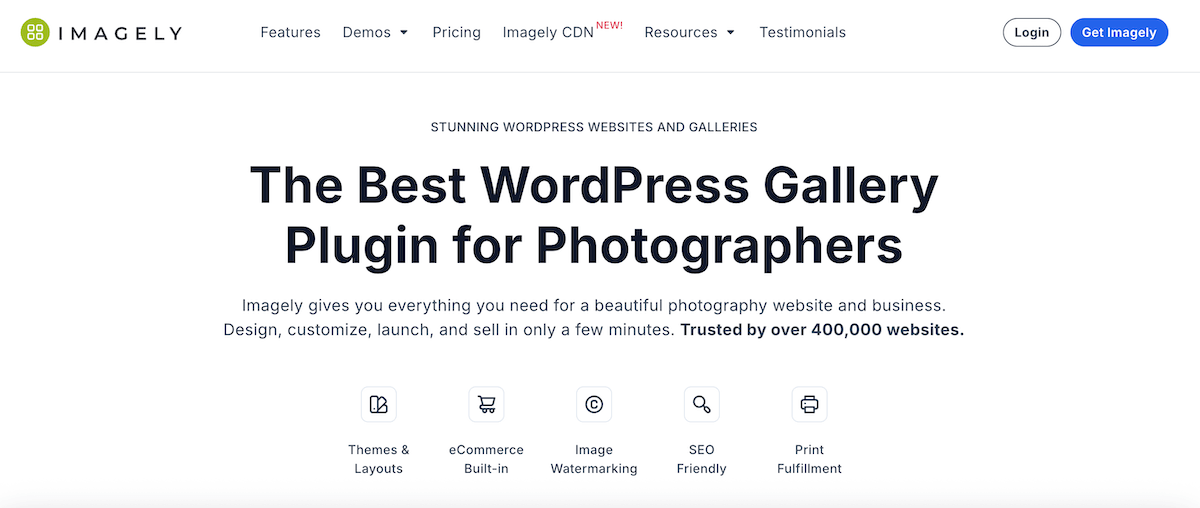
Imagely (formerly NextGEN Gallery) is a WordPress portfolio plugin built for selling photography with integrated ecommerce.
Best for: professional photographers needing ecommerce and image protection.
This popular WordPress gallery and portfolio plugin is built around helping people sell their photos or artistic works. It has the usual set of features, such as gallery layouts, lightbox pop-outs, lazy loading and mobile compatibility.
Imagely automates print fulfillment through partnerships with professional labs, handling everything from order processing to shipping. The plugin’s advanced proofing system lets clients select favorites and leave comments directly on images.
However, the features that make Imagely stand out are its ecommerce-focused functionalities, such as automated print fulfillment, auto tax calculations, and integrations with popular payment gateways like Stripe and PayPal. You can also add price lists to your galleries to help prospective clients choose which photo or image from your portfolio they want to buy.
Imagely’s pricing starts at $69.50 per year for use on a single website. However, their most popular plan costs $139.50 per year, which includes 96+ themes and designs, unlimited images and galleries, and use on up to 5 websites. FooGallery’s PRO Commerce plan offers similar ecommerce features at a lower price point with additional customization options. and designs, unlimited images and galleries, and use on up to 5 websites.
7. GridKit Portfolio Gallery
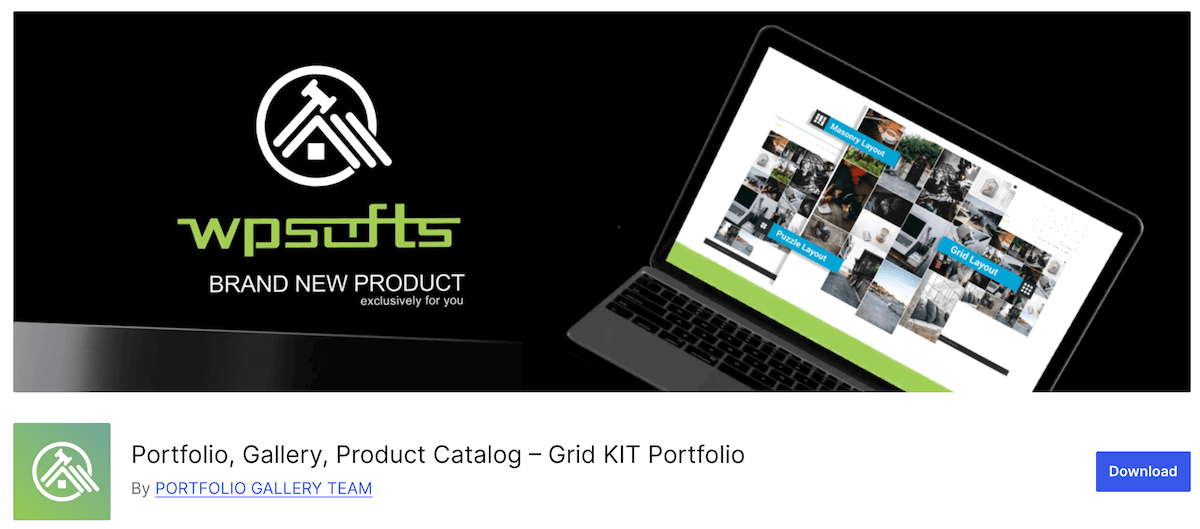
GridKit Portfolio Gallery is a WordPress portfolio plugin that offers masonry and puzzle-style grid layouts with CSS3 animations.
Best for: developers wanting unique interactive portfolios with animations.
This plugin excels at creating eye-catching portfolio presentations with its distinctive puzzle grid layout that automatically arranges images for optimal visual impact. The free version includes essential features like responsive design, basic filtering, and lightbox functionality.
GridKit’s animation library includes over 30 transition effects that trigger on scroll or hover, adding dynamic engagement to your portfolio. The plugin uses CSS3 animations rather than JavaScript, ensuring smooth performance even on mobile devices.
- Premium lifetime license unlocks unlimited portfolio items and advanced customization.
- Includes project detail pages with custom fields for comprehensive case studies.
- Built-in contact forms connect directly to portfolio items for lead generation.
While GridKit offers unique visual effects, FooGallery’s focus on performance optimization ensures faster load times for larger portfolios.
GridKit Portfolio Gallery is available in a free version, with its premium upgrade priced at around $49.99 (lifetime license) for access to advanced features.
8. Essential Grid 3

Essential Grid 3 is a WordPress portfolio plugin offering 50+ customizable templates for advanced users.
Best for: advanced users needing extensive customization.
Essential Grid is a gallery and portfolio plugin created by the developers of Slider Revolution, and the plugin stands out for allowing you to show your work in a more interactive format. It frames itself as a ‘no-code’ solution, giving you 50+ customizable templates, a drag-and-drop builder, and mix-and-match grid layouts to display your work. The plugin also has in-built watermarking and SEO features, such as pagination and deep linking.
Essential Grid’s advanced filtering system supports multiple taxonomies simultaneously, allowing visitors to refine portfolios by project type, year, client, and custom categories. The plugin’s cobbles layout creates Pinterest-style presentations that adapt fluidly to screen sizes.
Essential Grid pricing begins at $34 annually for the Basic plan, rising to $149 for their Professional plan. Each plan gives you progressively more sites (1, 3, or 5) on which you can use the plugin. FooGallery provides similar template variety with better performance optimization at comparable pricing.
Technical Features & Performance Impact
Understanding the technical specifications of portfolio plugins helps you make informed decisions about performance trade-offs. Here’s what matters most for maintaining speed while showcasing your work effectively.
Critical Technical Features:
Lazy loading implementation reduces initial page weight by loading images only as visitors scroll to them. This technique can cut initial load times significantly on image-heavy portfolios, directly improving user experience and bounce rates.
WebP format support decreases image file sizes by 25-35% compared to traditional JPEG files while maintaining visual quality. Modern portfolio plugins automatically serve WebP images to compatible browsers while ensuring fallbacks for older browsers.
CDN compatibility improves global load times by serving images from servers closest to your visitors. Premium plugins often include built-in CDN services or optimal integration with popular CDN providers.
- Responsive breakpoints: 768px (tablet), 480px (mobile).
- Image compression maintains quality while reducing file sizes.
- Browser caching reduces repeat visitor load times.
Core Web Vitals Considerations:
Portfolio plugins can impact Largest Contentful Paint (LCP) if not optimized properly. Plugins with progressive image loading and proper size attributes help maintain LCP scores under the recommended 2.5-second threshold.
Lazy loading prevents layout shifts affecting Cumulative Layout Shift (CLS) by reserving space for images before they load. Quality plugins specify image dimensions to eliminate unexpected layout jumps during page rendering.
Image compression reduces Time to First Byte (TTFB) by decreasing the overall data transfer required. Combined with server-side optimization, this ensures your portfolio responds quickly to visitor requests.
Mobile performance requires special attention since portfolio sites often receive significant mobile traffic. Plugins optimized for mobile deliver smaller image sizes and simplified layouts automatically based on device detection.
Choose the Right Portfolio Plugin to Showcase Your Work
We’ve looked at some of the top portfolio plugins for WordPress to give you a better understanding of useful features, performance criteria, and the options available to you. When creating your portfolio website, your selection should align with your specific presentation needs. However, advanced customization, high performance, and beautiful layouts should all factor into your decision.
Portfolio plugin selection depends on specific needs that vary significantly across creative disciplines. Your choice should reflect not just your current requirements but also anticipated growth and evolving client expectations.
- Photographers need ecommerce features and watermarking to protect and monetize their work.
- Agencies benefit from white-labeling and client galleries for professional presentations.
- Budget-conscious users should compare free version features before committing to premium plans.
Consider these decision factors when evaluating plugins: If you’re showcasing 50+ high-resolution images, performance optimization becomes critical. For client work requiring password protection, security features take priority. Mixed media portfolios need video support and varied layout options.
For fastest load times with 100+ images: FooGallery. For free dynamic layouts: Visual Portfolio. Each plugin serves different needs, but performance should never be compromised for features.
FooGallery is the most feature-rich and cost-effective solution on the list; at only $33.99 per year for the starter plan, it includes all the necessary features to get beautiful, fast-loading galleries set up on your website in minutes (such as with the built-in Portfolio template). FooGallery also places a lot of importance on performance, ensuring your load times and SEO aren’t sacrificed for visual appeal.
If you want to begin impressing potential clients with a stunning portfolio website, we recommend trying FooGallery. You can choose the best plan for your needs, or start a free 7-day trial of FooGallery today.
Frequently Asked Questions
Will portfolio plugins slow my WordPress site?
Not if you choose performance-optimized plugins. Modern portfolio plugins like FooGallery implement lazy loading, image compression, and CDN delivery to maintain fast load times. The key is selecting plugins that prioritize performance alongside visual features. Avoid plugins that load all images immediately or lack optimization features.
Which plugin loads fastest with 50+ images?
FooGallery consistently delivers the fastest load times for large galleries through its advanced lazy loading and image optimization. The plugin only loads images as needed, keeping initial page weight minimal. With proper configuration, FooGallery maintains sub-3-second load times even with 100+ high-resolution images.
Can I sell photos through portfolio plugins?
Yes, several portfolio plugins offer built-in ecommerce features. FooGallery PRO Commerce provides comprehensive WooCommerce integration for selling prints and digital downloads. NextGEN Gallery includes automated print fulfillment, while Envira Gallery offers basic sales functionality. Choose based on your specific sales needs and volume.
Do I need a portfolio plugin or theme?
Portfolio plugins offer more flexibility than portfolio themes. Plugins let you keep your existing theme while adding portfolio functionality exactly where needed. This approach means easier updates, better performance, and the ability to switch themes without losing your portfolio setup. Themes lock you into their structure, while plugins adapt to your needs.
What image formats work best for portfolios?
JPEG remains standard for photographs, offering good compression with minimal quality loss. PNG works best for graphics with transparency. GIF handles simple animations efficiently. WebP provides 25-35% smaller file sizes than JPEG while maintaining quality – use it when possible. Modern portfolio plugins like FooGallery automatically optimize and serve the best format for each visitor’s browser.
How do portfolio plugins affect SEO?
Quality portfolio plugins enhance SEO through proper image optimization, alt text management, and structured data implementation. Features like lazy loading improve Core Web Vitals scores, while XML sitemaps help search engines index your visual content. FooGallery includes SEO-focused features like deep linking and customizable metadata to improve your portfolio’s search visibility.
The Best WordPress Gallery Plugin
FooGallery is an easy-to-use WordPress gallery plugin, with stunning gallery layouts and a focus on speed and SEO.










